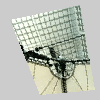 |
 |
 |
 |
| Nome |
|
textureMode() |
 |
|
|
| Exemplos |
|
 |
noStroke();
PImage a = loadImage("arch.jpg");
textureMode(IMAGE);
beginShape();
texture(a);
vertex(10, 20, 0, 0);
vertex(80, 5, 100, 0);
vertex(95, 90, 100, 100);
vertex(40, 95, 0, 100);
endShape();
|
 |
 |
noStroke();
PImage a = loadImage("arch.jpg");
textureMode(NORMALIZED);
beginShape();
texture(a);
vertex(10, 20, 0, 0);
vertex(80, 5, 1, 0);
vertex(95, 90, 1, 1);
vertex(40, 95, 0, 1);
endShape();
|
 |
|
| Descrição |
|
Sets the coordinate space for texture mapping. There are two options, IMAGE, which refers to the actual coordinates of the image, and NORMALIZED, which refers to a normalized space of values ranging from 0 to 1. The default mode is IMAGE. In IMAGE, if an image is 100 x 200 pixels, mapping the image onto the entire size of a quad would require the points (0,0) (0,100) (100,200) (0,200). The same mapping in NORMAL_SPACE is (0,0) (0,1) (1,1) (0,1). |
 |
|
|
| Sintaxe |
|
texture(MODE);
|
 |
|
|
| Parâmetros |
|
| MODE |
|
either IMAGE or NORMALIZED
|
|
 |
|
|
| Retorno |
|
Nenhum |
 |
|
|
| Utilização |
|
Application & Web |
 |
|
|
| Relacionado |
|
texture()
|
|
|


